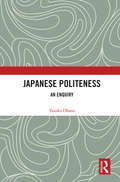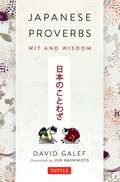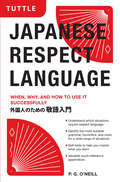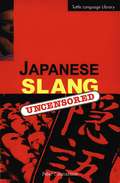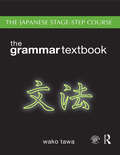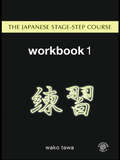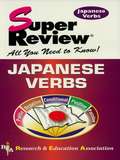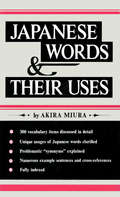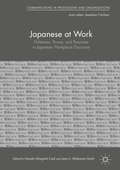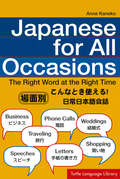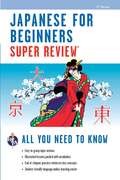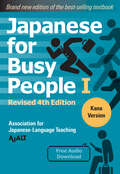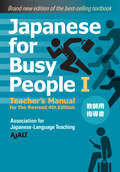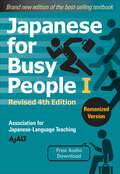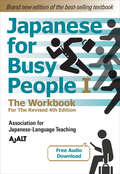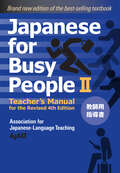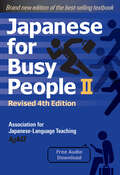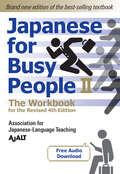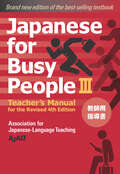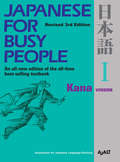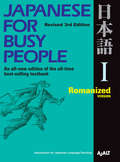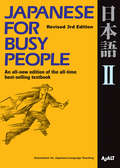- Table View
- List View
Japanese Politeness: An Enquiry
by Yasuko ObanaAlthough Japanese language is one of the most quoted examples in politeness research, extant publications focus on particular areas of politeness, and very few of them enquire into varied aspects of Japanese politeness. In this book, Yasuko Obana provides an integrated account of what signifies Japanese politeness. By examining how far previous assumptions can apply to Japanese, Obana exposes a variety of characteristics of Japanese politeness. By taking a diachronic approach, she probes into what constitutes politeness, extracts key elements of the term ‘polite’ in Japanese, and demonstrates how modern honorifics’ apparent diverse, divergent uses and effects can be integrated into a systematic matrix. Furthermore, by quoting traditional Japanese language scholars’ (kokugo gakusha) studies, Obana brings different views into the open. She also carves out politeness strategies in Japanese that have not been adequately explored to date. They often conform to the way in which honorifics behave because they often reflect social indexicality. This book is a good reference for scholars in pragmatics, particularly for those who are working on politeness. It is useful for Japanese language teachers who want to know how to teach Japanese politeness to non-native learners. Postgraduate students of Japanese or pragmatics will also find this book useful as a self-study book.
Japanese Proverbs
by David Galef Jun Hashimoto"Destroy a nation, but its mountains and rivers remain."--Japanese proverbThis is a collection of 200 Japanese proverbs with illustrations and explanations for each saying.Go beyond speaking Japanese-peek into the soul of Japan. Japanese Proverbs: Wit and Wisdom is a delightfully illustrated compilation of traditional Japanese proverbs and sayings. Some of the classic Japanese quotes and quotations, like "Fall down seven times, get up eight", capture the dogged perseverance of the Japanese heart. Others, such as "A red lacquer dish needs no decoration" illuminate both a universal truth and Japan's unique, aesthetic traditions. Japanese Proverbs: Wit and Wisdom has proverbs of great cultural significance as well as proverbs on matters of daily life and customs.Pleasing to expert and new-comer alike, the 200 traditional proverbs in this unique collection are presented in Japanese script (kana and kanji) and romanized (romaji) form, along with direct English translations. Similar proverbs are given from English, and the sumi-e style ink drawings are a delight in their own right.You'll speak Japanese with the verve and nuance of a native when you use these apt and witty expressions.
Japanese Proverbs
by David Galef Jun Hashimoto"Destroy a nation, but its mountains and rivers remain."--Japanese proverbThis is a collection of 200 Japanese proverbs with illustrations and explanations for each saying.Go beyond speaking Japanese-peek into the soul of Japan. Japanese Proverbs: Wit and Wisdom is a delightfully illustrated compilation of traditional Japanese proverbs and sayings. Some of the classic Japanese quotes and quotations, like "Fall down seven times, get up eight", capture the dogged perseverance of the Japanese heart. Others, such as "A red lacquer dish needs no decoration" illuminate both a universal truth and Japan's unique, aesthetic traditions. Japanese Proverbs: Wit and Wisdom has proverbs of great cultural significance as well as proverbs on matters of daily life and customs.Pleasing to expert and new-comer alike, the 200 traditional proverbs in this unique collection are presented in Japanese script (kana and kanji) and romanized (romaji) form, along with direct English translations. Similar proverbs are given from English, and the sumi-e style ink drawings are a delight in their own right.You'll speak Japanese with the verve and nuance of a native when you use these apt and witty expressions.
Japanese Proverbs
by David Galef Jun Hashimoto"Destroy a nation, but its mountains and rivers remain."--Japanese proverbThis is a collection of 200 Japanese proverbs with illustrations and explanations for each saying.Go beyond speaking Japanese-peek into the soul of Japan. Japanese Proverbs: Wit and Wisdom is a delightfully illustrated compilation of traditional Japanese proverbs and sayings. Some of the classic Japanese quotes and quotations, like "Fall down seven times, get up eight", capture the dogged perseverance of the Japanese heart. Others, such as "A red lacquer dish needs no decoration" illuminate both a universal truth and Japan's unique, aesthetic traditions. Japanese Proverbs: Wit and Wisdom has proverbs of great cultural significance as well as proverbs on matters of daily life and customs.Pleasing to expert and new-comer alike, the 200 traditional proverbs in this unique collection are presented in Japanese script (kana and kanji) and romanized (romaji) form, along with direct English translations. Similar proverbs are given from English, and the sumi-e style ink drawings are a delight in their own right.You'll speak Japanese with the verve and nuance of a native when you use these apt and witty expressions.
Japanese Respect Language: When, Why, and How to use it Successfully
by P. G. O'NeillRespect language—the special style of polite spoken or written Japanese—is involved almost every exchange of Japanese between one person and another, including the simplest phrases of greeting.<P><P> An understanding of its forms is therefore essential to any serious student of the Japanese language. This programmed course is carefully designed to teach the basic and correct forms which the learner should master for his or her own use, by first looking at the various typical situations to see when respect should and should not be shown in Japanese, and then going on to see how respect is expressed in special forms of speech. In this way the learner is shown how to identify the type of respect for used, the person to whom respect is being shown, and the equivalent form in colloquial language. The insights into both Japanese culture and language will help any student or businessperson traveling to Japan or speaking Japanese on a regular basis.
Japanese Slang
by Peter ConstantineReveals, in vivid detail, the richness of Japanese slang in all its amusing, bizarre and shocking forms.
Japanese Slang
by Peter ConstantineReveals, in vivid detail, the richness of Japanese slang in all its amusing, bizarre and shocking forms.
Japanese Stage-Step Course: Grammar-Reference
by Wako TawaThe Japanese Stage-Step Course is a fully integrated language course from beginner through to intermediate level combining cohesive grammar instruction with functional examples and practices to build a solid foundation in the four key skills of reading, writing, listening and speaking. The course includes the core text, The Grammar Textbook, Workbooks 1 and 2, Writing Practice Book, audio material on CDs or in MP3 format, and a Companion Website. An understanding of grammar is essential for students aiming to achieve a high level of proficiency in Japanese. Written by an experienced teacher, The Stage-Step Course: Grammar Textbook provides a step-by-step guide to Japanese grammar. With clear, accessible explanations and relevant examples to put each grammatical point into context, the Grammar provides a meaningful framework to develop the key skills of reading, writing, speaking and listening. The book is divided into the following four stages: Stage One: Building a foundation. Stage Two: Towards more complex structures. Stage Three: Adding sophistication. Stage Four: Referencing. Each lesson is accompanied by detailed vocabulary, conversation practice and reading exercises in the separate two workbooks to enable students to put into practice what they have learnt and consolidate their knowledge. The course also includes the Writing Practice Book, audio material on CDs or in MP3 format and a Companion Website.
Japanese Stage-Step Course: Workbook 1
by Wako TawaWorkbook 1 of the Japanese Stage-Step Course is designed to be used alongside Stage One of the Grammar Textbook. It contains grammar exercises, along with new vocabulary and conversational, listening, and reading practice for each chapter in the textbook, so that students will be able to thoroughly practice the grammatical structures they have learnt. Additional features include: detailed explanation of vocabulary items information on the system of Kanji abundant exercises including sentence as well as discourse practices extensive cross-referencing with the Grammar Textbook Japanese-English and English-Japanese glossary. All the audio material for Workbook 1 is available on CD1.
Japanese Verbs
by The Editors of REA P. SuskiREA's Super Reviews help students brush up on tough subjects. They are more thorough than ordinary subject reviews but less complex than voluminous study guides. Numerous solved problems accompany the review and bring it to life. Exercises and quizzes enable students to check whether they have learned what they need to know, whether they understand the subject and have command of it.
Japanese Words & Their Uses: 2
by Akira MiuraMany students dutifully memorize the simple English equivalents that are usually given for Japanese words-with the result that they speak poor Japanese.<P><P> Effective communication requires an understanding of the unique usages of Japanese vocabulary items, which often differ greatly from those of their English "equivalents." Until now, one of the biggest problems has been the lack of adequate reference materials on Japanese usage. This book fills the gap by concisely explaining 300 troublesome but essential words and phrases, which are alphabetically arranged for easy reference. It discusses not only how they should be used but also how they should not be used, contrasting them with their English "equivalents." The entries include many sample sentences and cross-references, along with notes on usage mistakes committed by the author's own students. Drawing on his long experience in teaching Japanese, as well as scholarly research, Professor Miura has produced a work that offers real help to students and teachers of the language everywhere.
Japanese at Work: Politeness, Power, And Personae In Japanese Workplace Discourse (Communicating In Professions And Organizations Ser.)
by Haruko Minegishi Cook Janet S. Shibamoto-SmithThis book empirically explores how different linguistic resources are utilized to achieve appropriate workplace role inhabitance and to achieve work-oriented communicative ends in a variety of workplaces in Japan. Appropriate role inhabitance is seen to include considerations of gender and interpersonal familiarity, along with speaker orientation to normative structures for marking power and politeness. This uniquely researched edited collection will appeal to scholars of workplace discourse and Japanese sociolinguistics, as well as Japanese language instructors and adult learners of Japanese. It is sure to make a major contribution to the cross-linguistic/cultural study of workplace discourse in the globalized context of the twenty-first century.
Japanese for All Occasions
by Anne Kaneko Sally MotomuraAt last. A book of useful Japanese, offering the language you need to handle a wide variety of situations. Through hundreds of example sentences and dialogues, you'll learn what to say and do when:Setting up a business appointmentOpening a bank accountMaking a wedding speechReserving a place to stayRenewing a visaand much moreIncluded is an additional chapter on writing cards and letters, featuring examples of New Year cards, thank-you notes, and normal letters.No other book covers colloquial Japanese as thoroughly as Japanese for All Occasions. Whether you're a student, traveler, or businessperson, you'll find that this book offers any easy and enjoyable way to improve your Japanese.
Japanese for Beginners Super Review - 2nd Ed. (Super Reviews Study Guides)
by The Editors of REAREA's Japanese for Beginners Super ReviewGet all you need to know with Super Reviews!2nd EditionREA's Japanese for Beginners Super Review contains an in-depth review that explains everything high school and college students need to know about the subject. Written in an easy-to-read format, this study guide is an excellent refresher and helps students grasp the important elements quickly and effectively.Our Japanese for Beginners Super Review can be used as a companion to high school and college textbooks, or as a handy resource for anyone who wants to improve their Japanese language skills and needs a fast review of the subject.Presented in a straightforward style, our review covers the material taught in a beginning-level Japanese language course, including: vocabulary, speech patterns, useful expressions, and more. Each illustrated lesson includes exercises to help students review what they've learned.
Japanese for Busy People Book 1: Revised 4th Edition (Japanese for Busy People Series)
by AJALT4th Revised Edition of JAPANESE FOR BUSY PEOPLE, the most popular Japanese language textbook series in the world. Since it was first published in 1984, the focus of the Japanese for Busy People series has always been to teach Japanese for effective communication. As suggested in the title, this is a concise course for busy students who want to learn natural, spoken Japanese as efficiently as possible in a limited amount of time. The new Japanese for Busy People: Revised 4th Edition is made up of three volumes: Book I, Book II, and Book III. Book I is available in both romanized and kana versions, similar to the Revised 3rd Edition. The Kana Version is exactly the same as the Romanized Version except for the scripts used throughout the book: hiragana and katakana. The Kana Version is therefore recommended for those who have already learned kana (as these scripts are collectively called) or are learning them with Japanese for Busy People Kana Workbook or another such text. Studying Japanese in kana, rather than in romanized script, can lead to fluent pronunciation and facilitate a smooth transition to the study of kanji.
Japanese for Busy People Book 1: Revised 4th Edition (Japanese for Busy People Series)
by AJALTJapanese for Busy People is the most popular Japanese language textbook series in the world. Japanese for Busy People series is one of the most comprehensive series containing texts, workbooks and teacher&’s manuals for all three volumes. Audio recordings for the dialogues and listening exercises are now available as free download from kodansha.us. Teacher&’s Manual provides specific suggestions for teachers on how to use the main text in a classroom setting and how to coordinate it with the workbook. CAN-DO section is useful in creating lesson plan and measuring learners&’ mastery level. It also contains a Japanese translation of all of the key components of the main text, such as culture notes, notes on Japanese grammar, and active communication. This first of three volumes introduces "survival Japanese" — the absolute minimum amount of Japanese needed to live in Japan. Thus, the vocabulary and grammatical items it introduces are limited to about a third of what is typically introduced in a first-year course. In addition, the book features notes on Japanese culture intended to expand the learner&’s understanding of Japan, its customs and people. Japanese for Busy People I is available in two formats: romanized and kana. The Romanized Version uses romanized Japanese throughout, with kana in the Opening Dialogues of each lesson. The Kana Version — exposing students to hiragana and katakana from the very beginning — uses only kana.The content of the two books is otherwise exactly the same. The companion volume, Japanese for Busy People 1: The Workbook for the Revised 4th Edition contains a variety of illustrated exercises for mastering the basic sentence patterns presented in the main text.
Japanese for Busy People Book 1: Revised 4th Edition (Japanese for Busy People Series)
by AJALT4th Revised Edition of JAPANESE FOR BUSY PEOPLE, the most popular Japanese language textbook series in the world.Since it was first published in 1984, the focus of the Japanese for Busy People series has always been to teach Japanese for effective communication. As suggested in the title, this is a concise course for busy students who want to learn natural, spoken Japanese as efficiently as possible in a limited amount of time.The new Japanese for Busy People: Revised 4th Edition is made up of three volumes: Book I, Book II, and Book III. Book I is available in both romanized and kana versions, similar to the Revised 3rd Edition.The Romanized Version uses romanized Japanese throughout, with kana in the Target Dialogues of each lesson.
Japanese for Busy People Book 1: Revised 4th Edition (Japanese for Busy People Series)
by AJALT4th Revised Edition of JAPANESE FOR BUSY PEOPLE, the most popular Japanese language textbook series in the world. Since it was first published in 1984, the focus of the Japanese for Busy People series has always been to teach Japanese for effective communication. Japanese for Busy People I: The Workbook for the Revised 4th Edition is for all learners who wish to improve their speaking and listening skills. It can be used in tandem with Japanese for Busy People I: Revised 4th Edition, both Kana Edition and Romanized Edition, or as independent study material. The workbook provides ample speaking and listening practice in the form of illustrated exercises that call on learners to construct dialogues and role-play in Japanese. Illustrations combined with conversations, which proceed at a natural pace in the audio recordings, help learners to feel as if they are actually experiencing each situation. Through repeated oral and listening practice, learners will come to acquire the rhythm of real-life Japanese conversation. Audio recordings can be downloaded for free from kodansha.us.
Japanese for Busy People Book 2: Revised 4th Edition (Japanese for Busy People Series)
by AJALTThe Teacher&’s Manual provides specific suggestions for teachers on how to use Japanese for Busy People Book II in a classroom setting and how to coordinate it with the workbook. CAN-DO section is useful in creating lesson plan and measuring learners&’ mastery level. It also contains a Japanese translation of all of the key components of the main text, such as culture notes, notes on Japanese grammar, and active communication.
Japanese for Busy People Book 2: Revised 4th Edition (Japanese for Busy People Series-4th Edition)
by AJALT4th Revised Edition of JAPANESE FOR BUSY PEOPLE, the most popular Japanese language textbook series in the world. Now comes with free downloadable audio recordings. Since it was first published in 1984, the focus of the Japanese for Busy People series has always been to teach Japanese for effective communication. Picking up where Japanese for Busy People Book I left off, Japanese for Busy People Book II goes beyond survival Japanese, turning to the basics of Japanese syntax, enabling learners to make a smooth transition from mid-beginner-level to intermediate-level Japanese. Grammar and content topics are carefully selected to assist learners to effectively develop sentence patterns and vocabulary related to each topic through the practice of talking about them. Kanji (Chinese characters used in Japanese) are gradually introduced in Book II along with furigana so that learners know how to pronounce them. By the end of the book, learners will have acquired through a series of concise grammatical explanations and extensive speaking and listening exercises a command of Japanese that will enable them to carry on a variety of daily conversations. Audio recordings can be downloaded for free from kodansha.us.
Japanese for Busy People Book 2: The Workbook for the Revised 4th Edition (free audio download) (Japanese for Busy People Series-4th Edition)
by AJALT4th Revised Edition of JAPANESE FOR BUSY PEOPLE, the most popular Japanese language textbook series in the world. Now comes with free downloadable audio recordings. Since it was first published in 1984, the focus of the Japanese for Busy People series has always been to teach Japanese for effective communication. Japanese for Busy People II: The Workbook for the Revised 4th Edition helps learners to comprehend plain forms of verbs, time expressions, conditional clauses and other difficult elements of grammar that will enable them to master intermediate-level Japanese. Learners can expand their vocabulary and hone their speaking, listening, reading and writing skills through many exercises provided in the workbook. Audio recordings can be downloaded for free from kodansha.us.
Japanese for Busy People Book 3: Revised 4th Edition (Japanese for Busy People Series-4th Edition)
by AJALTThe Teacher&’s Manual provides specific suggestions and practical examples for teachers on how to use Japanese for Busy People Book III in a classroom setting and how to coordinate it with the accompanying workbook. CAN-DO section is useful in creating lesson plans and measuring learners&’ mastery level. It also provides Japanese translations of all of the key components of the main text, such as culture notes, notes on Japanese grammar, and active communication.
Japanese for Busy People I: Kana Version (Japanese for Busy People Series)
by AJALTJapanese for Busy People is the most popular Japanese language textbook series in the world. With over 20 components including texts, workbooks, CDs, videos and teacher&’s manuals, it is also one of the most comprehensive. Now, a decade after its first revision, the entire series is being redesigned, updated and consolidated to meet the needs of 21st-century students and businesspeople who want to learn natural, spoken Japanese as effectively as possible in a limited amount of time.The book features not only a sleek, new design but also a unit structure that groups thematically linked lessons together, making it easier than ever to learn Japanese. Moreover, it now comes with a CD containing audio for the dialogues and listening exercises from the text. The exercises in the book have also been thoroughly revised to incorporate more comprehension and production tasks. Many of these exercises are illustrated, making for a stimulating learning experience, and the purpose of each one is clearly stated.This first of three volumes introduces "survival Japanese" — the absolute minimum amount of Japanese needed to live in Japan. Thus, the vocabulary and grammatical items it introduces are limited to about a third of what is typically introduced in a first-year course. In addition, the book features notes on Japanese culture intended to expand the learner&’s understanding of Japan, its customs and people.Japanese for Busy People I is available in two formats: romanized and kana. The Romanized Version uses romanized Japanese throughout, with kana in the Opening Dialogues of each lesson.The Kana Version — exposing students to hiragana and katakana from the very beginning — uses only kana.The content of the two books is otherwise exactly the same.The companion volume, Japanese for Busy People 1: The Workbook for the Revised 3rd Edition contains a variety of illustrated exercises for mastering the basic sentence patterns presented in the main text.
Japanese for Busy People I: Romanized Version (Japanese for Busy People Series #1)
by AJALTJapanese for Busy People is the most popular Japanese language textbook series in the world. With over 20 components including texts, workbooks, CDs, videos and teacher&’s manuals, it is also one of the most comprehensive. Now, a decade after its first revision, the entire series is being redesigned, updated and consolidated to meet the needs of 21st-century students and businesspeople who want to learn natural, spoken Japanese as effectively as possible in a limited amount of time.The book features not only a sleek, new design but also a unit structure that groups thematically linked lessons together, making it easier than ever to learn Japanese. Moreover, it now comes with a CD containing audio for the dialogues and listening exercises from the text. The exercises in the book have also been thoroughly revised to incorporate more comprehension and production tasks. Many of these exercises are illustrated, making for a stimulating learning experience, and the purpose of each one is clearly stated.This first of three volumes introduces "survival Japanese" — the absolute minimum amount of Japanese needed to live in Japan. Thus, the vocabulary and grammatical items it introduces are limited to about a third of what is typically introduced in a first-year course. In addition, the book features notes on Japanese culture intended to expand the learner&’s understanding of Japan, its customs and people.Japanese for Busy People I is available in two formats: romanized and kana. The Romanized Version uses romanized Japanese throughout, with kana in the Opening Dialogues of each lesson.The Kana Version — exposing students to hiragana and katakana from the very beginning — uses only kana.The content of the two books is otherwise exactly the same.The companion volume, Japanese for Busy People 1: The Workbook for the Revised 3rd Edition contains a variety of illustrated exercises for mastering the basic sentence patterns presented in the main text.
Japanese for Busy People II: Revised 3rd Edition (Japanese for Busy People Series)
by AJALTVolume I dealt with "survival Japanese" for tourists and other short-term travelers and newcomers to Japan. Volume II, meanwhile, turns to the basics of Japanese syntax. The book is by no means only about grammar, however. Rather, it is designed to help learners consolidate their understanding of syntactical structure through lessons that focus on how to talk about topics relevant to daily life. In addition to serving learners continuing from Volume I, Volume II will benefit those who have already studied beginning Japanese to some extent but wish to brush up on syntax. Major Features of Japanese for Busy People II, Revised 3rd Edition, will enable learners to progress smoothly through the equivalent of the latter half of a typical first-year Japanese course while gradually building speaking and listening skills. Learners approaching mid-beginner status often find themselves suddenly faced with syntax and vocabulary much more complex than what they have studied before. Such grammar and vocabulary do not appear as frequently in everyday conversation as those words and structures they have learned up to this point, necessitating that they spend ample time on review. Moreover, learners at this stage are expected to become familiar with verb tense and aspect, time expressions, conditional clauses, and other topics that require them to have a solid grasp of context and speaker intent if they are to fully understand the differences in meaning conveyed by each. Japanese for Busy People II helps overcome the above obstacles through grammar and content topics carefully selected to be appropriate to learners at this level of Japanese proficiency. The book is designed so that by practicing talking about each topic, learners will gradually and effectively acquire sentence patterns and vocabulary related to that topic. Like Volume I, Volume II is organized into several large units, each covering topics grouped under a particular theme. In this way, the book enables learners to achieve a well-balanced understanding of grammar, sentence structure, and context.
